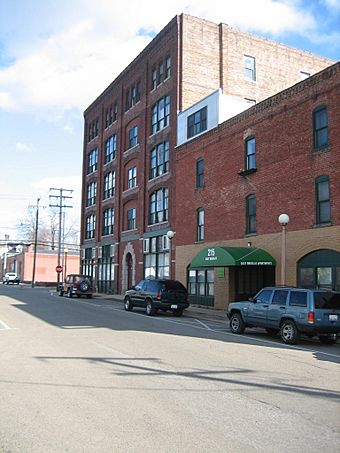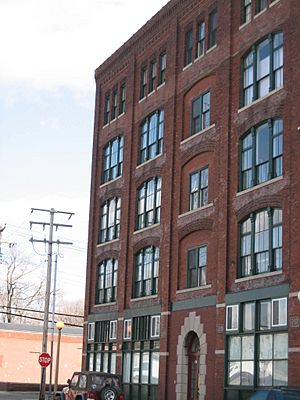White Building (Bloomington, Illinois) facts for kids
Quick facts for kids |
|
|
White Building
|
|

Front of the building
|
|
| Location | 215-223 E. Douglas St., Bloomington, Illinois |
|---|---|
| Area | Less than 1 acre (0.40 ha) |
| Built | 1894-1895 |
| Built by | Samuel R. White |
| Architectural style | Chicago School |
| NRHP reference No. | 94000612 |
| Added to NRHP | June 17, 1994 |
The White Building, also known as the Heberling Building, is a historic building in Bloomington, Illinois, United States. It is located on East Douglas Street in Bloomington. This building was added to the National Register of Historic Places in June 1994. It is a good example of Commercial style architecture, which is also known as the Chicago School style. Samuel R. White built the five-story red brick building in 1894-1895. He built it to house his furniture sales company. By 1903, the Heberling Brothers pharmacy used most of the building. The White Building also has a three-story part connected to its west side. This smaller part was likely built before the main building.
Contents
History of the White Building
The White Building was built by Samuel R. White, a businessman from Bloomington. He built it between 1894 and 1895. White moved to Bloomington in 1870. At that time, Bloomington was an important economic center.
Samuel White's Early Businesses
In 1872, Samuel White started his own construction business. He built many buildings in Bloomington and other Illinois cities. These included the First Ward School in Bloomington. He also built parts of the Pullman Company in Chicago. In 1873, White started a coal company and a lumber yard. A lumber yard is a place where wood is stored and sold.
In 1878, White founded S.R. White Manufacturing. This company became one of Bloomington's top manufacturers. They first made furniture in an old mill. By 1883, they moved to new facilities. These included a planing mill and a factory. A planing mill shapes wood. The company then started making sashes, doors, blinds, and finished wood. A sash is the frame that holds window glass.
Building the White Building
White's factory had two fires between 1884 and 1887. Because of this, he had to rebuild with safer brick structures. His factory grew over time. It became the mill for the furniture store White opened in 1894-1895. This new store was inside the White Building.
When the building was finished, White's furniture store used the top three floors. They also used the basement and the building next door. The third floor had woodworking machines. The fourth floor was for machine and bench work. The fifth floor was used for finishing furniture and storage. The three-story building next to it stored lumber. This smaller building was likely built before the main White Building. However, both buildings are important together.
Other Businesses and the Heberling Brothers
White's furniture company did not use the first two floors. Other businesses rented these spaces. A pharmacy was on the first floor. The Gordon Manufacturing Company was on the second floor. They made metal oil cans. There was also a blacksmith shop somewhere in the building.
In 1900, a big fire destroyed most of downtown Bloomington. Luckily, the fire stopped before reaching the White Building. In 1903, the Heberling Brothers bought the pharmacy on the first floor. The next year, they moved their own company into the building. This company was called Heberling Medicinal and Extract Company. By 1910, the Heberlings used more and more of the building. White's furniture company then moved all its operations. They moved to the S.R. White Manufacturing Company plant across the street.
Architecture of the White Building
The White Building mixes a typical factory design with a need for safety and good looks. It is a great example of Commercial style architecture in Bloomington. This style is also known as Chicago School. It shows how buildings can be useful and beautiful at the same time. This building style is known for its many windows, called fenestration. Many features of this style came from the needs of businesses and factories.
Building Structure and Size
The White Building has five stories. It also has a three-story part on its west side. It is located near the corner of Douglas and Prairie Streets in Bloomington. The building is about two blocks east of the main downtown area. The five-story part is about 112 feet long and 70 feet wide. The three-story part is about 80 feet long and 50 feet wide. The smaller building was probably used as a stable before. It was made into an addition to the White Building after the main building was finished in 1895.
Inside and Outside Features
The inside of the building has a timber frame structure. This means it uses large wooden beams and posts. The outside walls are made of strong brick. These walls support the building's weight. The masonry basement has windows and rises a few feet above the ground. The roof is very flat and cannot be seen from the street. The three-story part on the west side also has a timber frame and brick structure. It has a small fourth-floor section with a clerestory window. A clerestory window is a window high up on a wall.
Significance of the White Building
The White Building is an important example of an industrial Commercial style building in Bloomington. It is the best building of its kind and style left in the city. There are other similar buildings, but they are not as visible. They are often hidden by overpasses built later. These other buildings are also simpler in design than the White Building. The White Building was added to the U.S. National Register of Historic Places on June 17, 1994.




